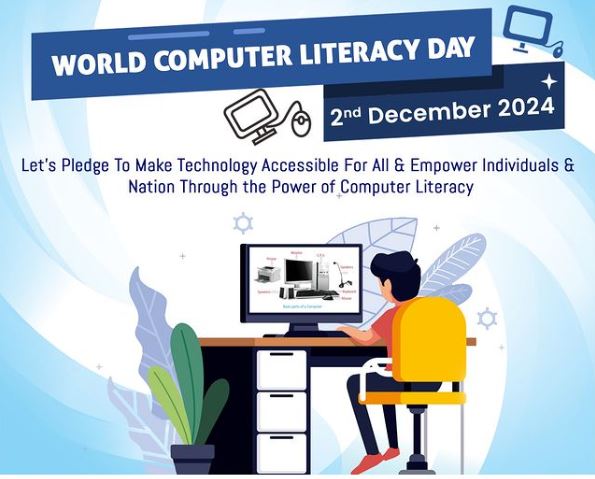
World Computer Literacy Day, celebrated on December 2nd, underscores the importance of digital skills in today’s society. This year’s theme, “Bridging the Digital Divide,” highlights the need for equitable access to technology. In India, computer literacy is a pressing issue. Currently, only 24.7% of individuals aged 15 and above are computer literate. This statistic reveals significant disparities, particularly between urban and rural areas.
The Historical Context of Computer Literacy in India
Computer literacy in India has evolved since the early 1990s when economic liberalization introduced technology to the masses. The Digital India campaign, launched in 2015, aimed to transform India into a digitally empowered society. However, progress has been slow. Despite initiatives, as of 2021, computer literacy rates show that 18.1% of rural individuals are literate compared to 39.6% in urban areas.
The history of computer literacy initiatives can be traced back to organizations like NIIT (National Institute of Information Technology), which started promoting IT knowledge across India in the late 1980s.
World Computer Literacy day was first celebrated in 2001, initiated by NIIT to mark its 20th anniversary. As R. Srikantan, former CEO of NIIT, stated, “Education is the key to unlocking potential.” This emphasizes the vital role of education in bridging the digital gap.
Current Statistics and Trends
Recent studies reveal alarming statistics:
- Only 12% of Indians over 15 years are computer literate.
- Among those who are literate, only 15.6% can send emails with attachments.
- A mere 1.4% can write a computer program using specialized languages.
These figures indicate a stark reality: many young graduates from rural areas lack basic computer skills. The divide is evident; urban males lead in literacy rates, followed by urban females, rural males, and finally rural females.
The Importance of Computer Literacy
Computer literacy is crucial for accessing essential services like banking, healthcare, and government resources. It enhances quality of life and fosters economic development. During the COVID-19 pandemic, digital skills became vital for online education and remote work. Digital money apps have redefined the way that we Indians do our purchases.
As noted by Ashwini Vaishnaw, Minister for Electronics and Information Technology, Government of India: “Digital literacy is not just an option; it is a necessity for every citizen. It empowers individuals, enhances their employability, and enables them to access essential services in today’s digital age.”
According to Nandan Nilekani, Co-founder of Infosys and Chairman of the Unique Identification Authority of India (UIDAI), “In a rapidly changing world, computer literacy is the key to unlocking opportunities. We must ensure that every Indian has the skills needed to thrive in a digital economy.”
These statements highlight the urgent need for the widespread acquiring of digital skills.
Benefits of Computer Literacy
- Access to Services: Individuals can utilize online banking and telemedicine.
- Educational Opportunities: Students benefit from online learning platforms.
- Employment Prospects: Computer skills significantly enhance employability.
- Economic Growth: Regions with higher literacy rates tend to have better socio-economic outcomes.
Holistic Changes Needed for Enhanced Computer Literacy
To improve computer literacy across India, several holistic changes must be implemented:
1. Enhance School Programs
Schools should integrate computer education from an early age. This ensures every student graduates with essential digital skills. The National Education Policy (NEP) 2020 emphasizes technology integration in education.
2. Invest in Infrastructure
The government must allocate resources for better facilities and training programs in schools and colleges. A robust infrastructure is necessary for effective learning.
3. Target Adult Education
Programs aimed at adults, especially in rural areas, need to be developed. Local bodies and NGOs should play a role in this initiative.
4. Focus on Disadvantaged States
Special initiatives should target states with low literacy rates like Assam and Bihar to bridge the digital divide.
Bridging the Digital Divide: Empowering Marginalized Communities
Efforts on World Computer Literacy Day focus on empowering marginalized communities. Programs that target women and economically disadvantaged groups are essential for reducing inequalities.
The Internet Saathi Program, launched by Google India and Tata Trusts in 2015, aims to facilitate digital literacy among rural Indian women. This initiative has trained thousands of women across various states, enabling them to access information and services online.
Educational Initiatives: Success Stories and Challenges
Various organizations have implemented successful computer literacy programs:
- The Pradhan Mantri Gramin Digital Saksharta Abhiyan (PMGDISHA) aims to enhance digital literacy among rural citizens by covering 60 million households.
- The National Digital Literacy Mission (NDLM) seeks to train 52.5 lakh individuals, including Anganwadi workers and ASHA workers.
However, challenges remain:
- Many schools lack qualified teachers.
- Infrastructure is inadequate in rural areas.
- There is a generational divide; older individuals often resist learning new technologies.
Government Initiatives Required for Improvement
To enhance computer literacy effectively, several government initiatives are necessary:
- Expand PMGDISHA: Increase funding and outreach efforts to cover more households.
- Strengthen Digital Infrastructure: Improve internet connectivity in rural areas through projects like BharatNet.
- Create Awareness Campaigns: Launch campaigns to promote the importance of digital skills among all age groups.
- Partnerships with NGOs: Collaborate with non-governmental organizations to reach underserved communities effectively.
- Quality Control Measures: Implement monitoring systems to evaluate the effectiveness of digital literacy programs.
The Youth Factor: Preparing for a Digital Future
Young people are more likely to embrace technology. The highest computer literacy rate is found among those aged 20-24 at 45.9%, while it drops significantly for older individuals (4.4% for ages 65-69).
This trend raises questions: How can we motivate older generations to learn? What incentives can be provided?
Conclusion: A Call to Action
In conclusion, enhancing computer literacy in India requires collective efforts from government bodies, private sectors, and civil society. Bridging the digital divide is not just about improving statistics; it’s about empowering individuals and communities.
We must ask ourselves: Are we doing enough? How can we contribute?
On this World Computer Literacy day, let’s advocate for policies that promote digital education and support initiatives that empower marginalized communities. Together, we can create a digitally inclusive society where everyone has the opportunity to thrive.
Join the Movement this World Computer Literacy Day!
This World Computer Literacy Day, take action! Support local initiatives or volunteer your time to teach someone a digital skill. Let’s work together to make computer literacy accessible for all! By focusing on these key areas—education, infrastructure, targeted initiatives—we can pave the way for a digitally inclusive future in India where everyone can participate fully in society’s advancements through technology.

Bridging the digital divide through empowerment of yputh and marginalised sections of the society is very essential for development of the country
Absolutely! Thank you, Naveen.
A well-written piece that highlights both the progress and challenges in digital literacy. Collective efforts in education and infrastructure are essential for a digitally inclusive future
Thank you Manish for expressing your views! To bridge the digital divide, especially in rural areas, as you said, impetus should be given towards digital literacy along with advancements in the infrastructure required for this. Besides, focus should also be given in creation of more jobs requiring digital skills, especially in rural areas so that the youth and the employable sections of people can avail of jobs in their own areas, without having to travel to cities, which would further result in population explosion, in large cities.